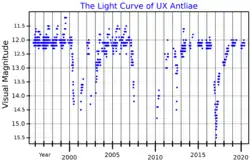UX Antliae
UX Antliae is a post-AGB and R Coronae Borealis variable star that has a base apparent magnitude of around 11.85, with irregular dimmings down to below magnitude 18.0.[8]
| Observation data Epoch J2000.0 Equinox J2000.0 | |
|---|---|
| Constellation | Corona Borealis |
| Right ascension | 10h 57m 9.051s[2] |
| Declination | −37° 23′ 55.06″[2] |
| Apparent magnitude (V) | 11.85 - 18.0[3] |
| Characteristics | |
| Spectral type | C(F)[4] |
| Variable type | R CrB[5] |
| Astrometry | |
| Radial velocity (Rv) | 27.83[6] km/s |
| Proper motion (μ) | RA: -3.8[2] mas/yr Dec.: 2.3[2] mas/yr |
| Distance | ~25,000[4] pc |
| Absolute magnitude (MV) | ~−5[4] |
| Details | |
| Mass | 0.722[7] M☉ |
| Surface gravity (log g) | 0.5[7] cgs |
| Temperature | 7,000[7] K |
| Other designations | |
| Database references | |
| SIMBAD | data |
Researchers David Kilkenny and J.E. Westerhuys of the South African Astronomical Observatory confirmed that UX Antliae was an R Coronae Borealis variable in 1990 after noting the similarity of its spectrum to the RCB star W Mensae.[9] It had been suspected of being one since 1940, but had been little-studied and exhibited no characteristic declines between 1975 and 1990.[4]
Assuming that its absolute magnitude is around -5, it has been estimated as lying 25000 parsecs distant from Earth.[4] Kilkenny and Westerhuys noted that its spectrum fit with that of a star of spectral class F, although was deficient in hydrogen.[9] It has around 70% the mass of the Sun and an effective (surface) temperature of around 7000 K.[7]
See also
References
- "Download Data". aavso.org. AAVSO. Retrieved 1 October 2021.
- Høg, E.; Fabricius, C.; Makarov, V. V.; Urban, S.; Corbin, T.; Wycoff, G.; Bastian, U.; Schwekendiek, P.; Wicenec, A. (2000). "The Tycho-2 catalogue of the 2.5 million brightest stars". Astronomy and Astrophysics. 355: L27. Bibcode:2000A&A...355L..27H. doi:10.1888/0333750888/2862.
- Otero, Sebastian (23 November 2012). "UX Antliae". The International Variable Star Index. Retrieved 14 July 2014.
- Lawson, W. A.; Cottrell, P. L.; Kilkenny, D.; Gilmore, A. C.; Kilmartin, P. M.; Marang; Roberts; Van Wyk (1994). "The Variability of the R-Coronae Star Ux-Antliae at Maximum Light". Mon. Not. R. Astron. Soc. 271 (4): 919–23. Bibcode:1994MNRAS.271..919L. doi:10.1093/mnras/271.4.919.
- Hema, B. P.; Pandey, Gajendra; Lambert, David L. (2012). "The Galactic R Coronae Borealis Stars: The C2 Swan Bands, the Carbon Problem, and the 12C/13C Ratio". The Astrophysical Journal. 747 (2): 102. arXiv:1201.1357. Bibcode:2012ApJ...747..102H. doi:10.1088/0004-637X/747/2/102. S2CID 118653032.
- White, Russel J.; Gabor, Jared M.; Hillenbrand, Lynne A. (2007). "High-Dispersion Optical Spectra of Nearby Stars Younger Than the Sun". The Astronomical Journal. 133 (6): 2524. arXiv:0706.0542. Bibcode:2007AJ....133.2524W. doi:10.1086/514336. S2CID 122854.
- Stasińska, G.; Szczerba, R.; Schmidt, M.; Siódmiak, N. (2006). "Post-AGB stars as testbeds of nucleosynthesis in AGB stars". Astronomy and Astrophysics. 450 (2): 701. arXiv:astro-ph/0601504. Bibcode:2006A&A...450..701S. doi:10.1051/0004-6361:20053553. S2CID 12040452.
- Otero, Sebastian (23 November 2012). "V4199 Sgr". The International Variable Star Index. Retrieved 14 July 2014.
- Kilkenny, D.; Westerhuys, J. E. (1990). "Spectroscopy of 'RCB' stars-IV. UX ANT". The Observatory. 110: 90–92. Bibcode:1990Obs...110...90K.
External links
"Post-AGB Object 279.064 +20.120". www.ncac.torun.pl.
"Light Curve of UX Ant". www.kusastro.kyoto-u.ac.jp.
